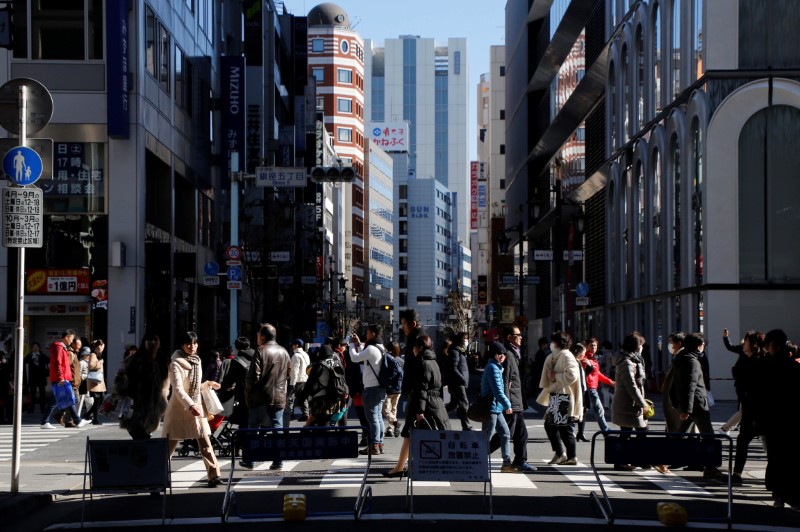By Stanley White and Leika Kihara
TOKYO (Reuters) - Japan's economy expanded at the fastest pace in more than two years in the second quarter as consumer and company spending picked up, highlighting a long-awaited bounce in domestic demand.
The world's third-largest economy expanded by a much stronger-than-expected annualised rate of 4.0 percent in April-June, posting its longest uninterrupted run of growth in a decade, government data showed on Monday.
Activity is expected to continue to improve in coming quarters, offering the Bank of Japan (BOJ) hope that a tight labour market is finally starting to boost wages and consumer spending, which in turn should make it easier to generate sustained inflation.
The rosy data was also a vindication for Japanese Prime Minister Shinzo Abe's government, which has faced criticism that its economic agenda has not done enough to revive the country's fortunes.
"The engines of consumer spending and capital expenditure both fired well in the second quarter, and that's why domestic demand was so strong," said Hidenobu Tokuda, senior economist at Mizuho Research Institute.
"The pace of growth may moderate slightly, but we are still in recovery mode. This is a positive development for inflation."
Gross domestic product expanded an annualised 4.0 percent in April-June, government data showed, more than the median estimate for 2.5 percent annualised growth and the biggest increase since January-March 2015.
Compared to the previous quarter, the economy expanded 1.0 percent, versus the median estimate for 0.6 percent growth.
Japan's growth had been largely reliant on robust exports earlier in the year, though there were signs private consumption was picking up.
Annualised GDP for previous quarter was revised up to a 1.5 percent increase, while quarterly real (inflation adjusted) GDP was revised up to 0.4 percent growth from a 0.3 percent increase.
The economy grew for six straight quarters in April-June. The last time the economy had a run of six consecutive quarters of growth was January-March 2005 through April-June 2006.
Private consumption, which accounts for about two-thirds of GDP, rose 0.9 percent from the previous quarter, more than the median estimate of 0.5 percent growth.
That marked the fastest expansion in more than three years as shoppers splashed out on durable goods such as cars and home appliances. Consumers also spent more money on dining out, the data showed. These are all encouraging signs that consumer spending is no longer the weak spot in Japan's economic outlook.
Employees' wages rose 0.7 percent in April-June from the previous quarter, which was the biggest increase since July-September last year and another sign of the economy's vigour.
"The fact that the economy was able to grow this much without gains in exports shows our fundamentals are solid," said Hiroshi Miyazaki, senior economist at Mitsubishi UFJ Morgan Stanley (NYSE:MS) Securities.
"Consumption gains could slow a little in the following quarter, but the foundations for a recover in consumer spending are in place."
Capital expenditure jumped by 2.4 percent in April-June from the previous quarter, doubling the median estimate for a 1.2 percent increase. That was the fastest growth in business investment since January-March 2014 as companies spent more on software and construction equipment.
Japanese Economy Minister Toshimitsu Motegi was more cautious on the outlook for domestic demand and pledged to implement extra measures to strengthen the economy.
"If you ask me whether private consumption has fully recovered, I would say it still lacks strength in some areas, which will need to be followed with policy," Motegi told reporters.
"We'll make sure that the domestic demand-led recovery continues. What is needed is supply-side reform. We'll focus our efforts on human resource investment, improvement in productivity, and new growth strategies."
While growth was faster than expected, it is not expected to nudge the Bank of Japan into dismantling its massive stimulus programme any time soon, as inflation remains stubbornly weak.
External demand subtracted 0.3 percentage point from GDP growth in April-June in part due to an increase in imports. This is notable because Japan usually relies on exports to drive growth.
Since launching quantitative easing in April 2013, the BOJ has pushed back the timing for reaching its 2 percent inflation target six times due in part to weak consumer spending.

The GDP data for April-June show private consumption is finally starting to move in the direction that the BOJ and other government ministers have long predicted.